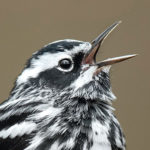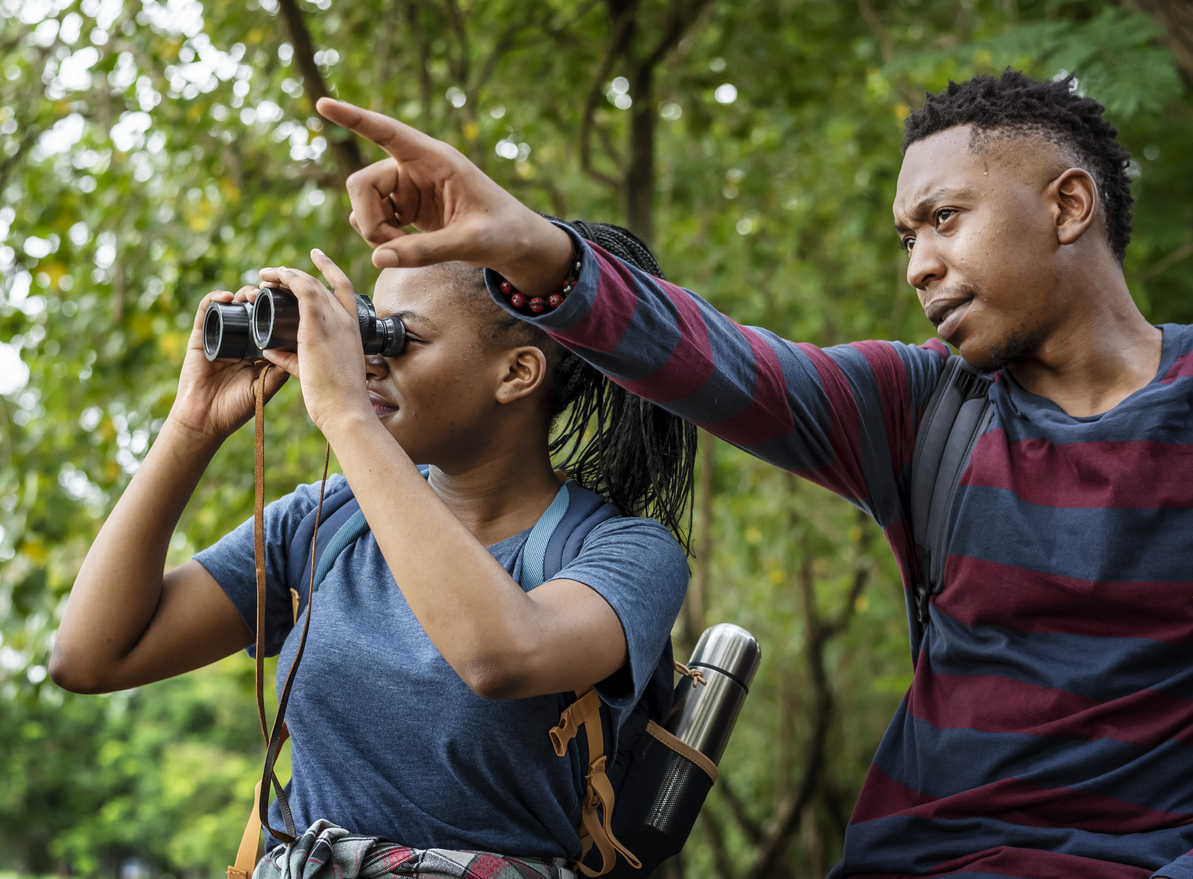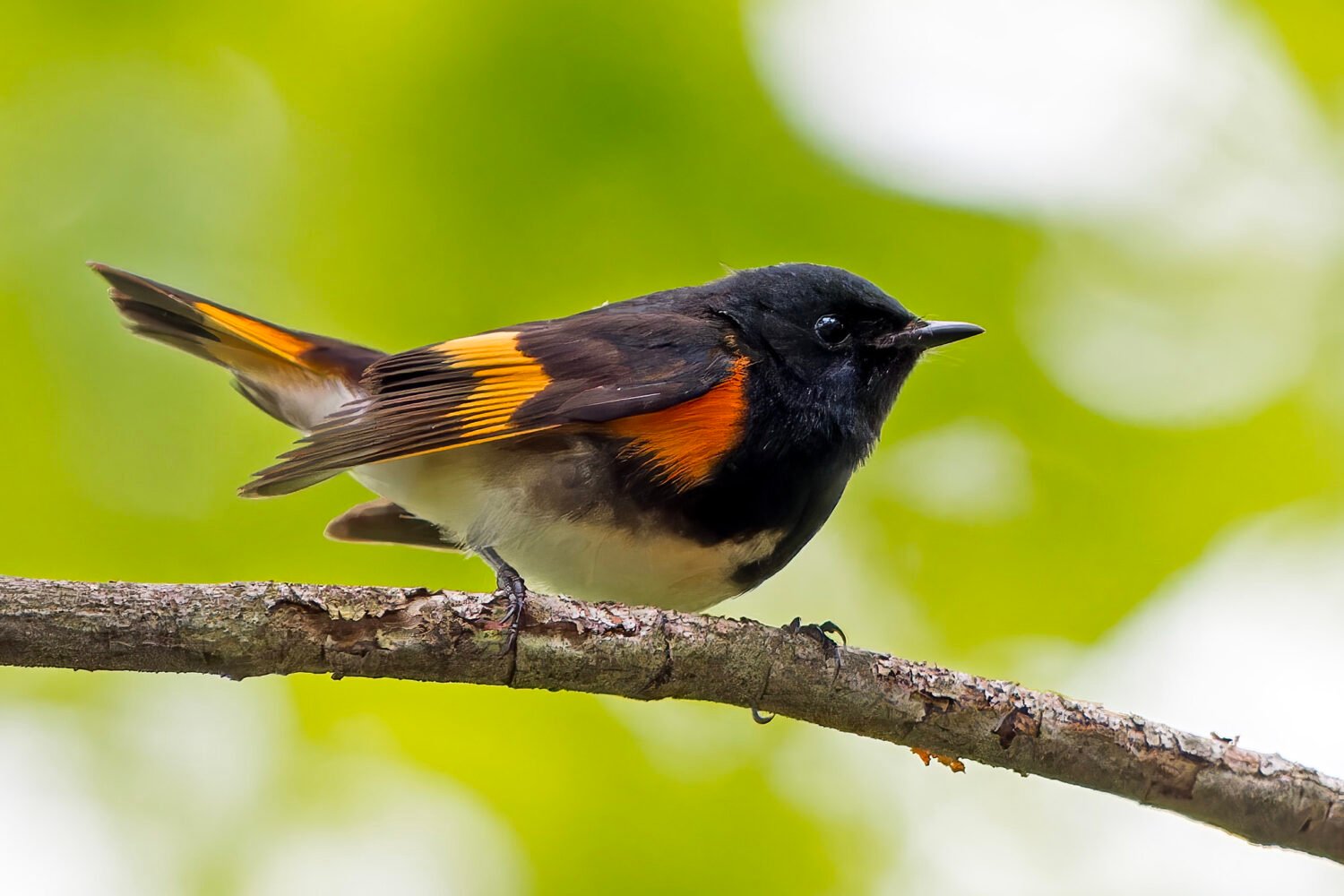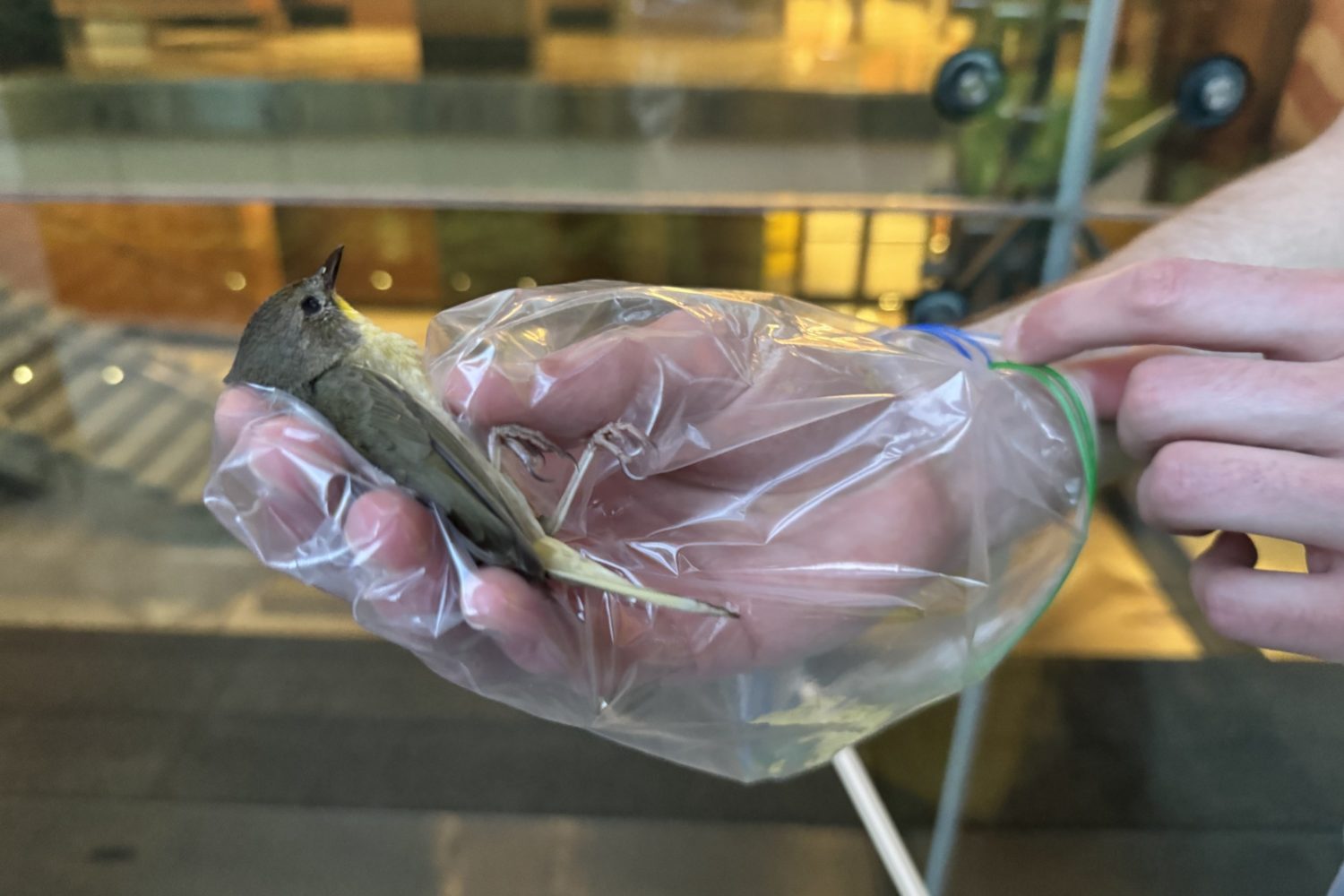My journey into birdwatching began more as sociology than ornithology.
A few years ago, I noticed an old classmate from high school, whom I’d known as a burly, bearded “drink and fight” type, posting pictures of birds on social media. More recently, a new hire at my office—younger than me and seemingly socially capable—introduced himself as a birdwatcher.
This surprised me. I’d always thought of birdwatching as the realm of retirees, bores, social misfits, and the athletically disinclined.
“Nerdy old white people who are eccentric and wear fanny packs and those weird visors,” a birder named Nick Lund told me, recalling his early preconceptions. “And khaki vests with tons of pockets. I don’t know where I got those ideas. But I think they exist for most people.”
Yet I began encountering signs that the pastime was, vaguely, becoming cool. Birding Instagram accounts and BuzzFeed quizzes were gaining popularity. What was happening? Lund—who recently left Washington to work for the National Audubon Society’s Maine chapter—attributes the hobby’s current popularity to social media (and, naturally, the efforts of Audubon). Potential birders, he says, are finding community. Indeed, my old classmate says Facebook groups provided him with support and enthusiasm when he first developed an interest in bird photography.
Still, I wanted to know: What is it about birding that attracts people?
The first step was gear. I ordered a pair of tiny $13 binoculars on Amazon. Birders, I came to learn, call them “bins” or “binos.” I favor “binocs.” It soon became apparent that these binoculars were inadequate. On Audubon’s buying guide, the cheapest pair in its entry-level “Get in the Game” category cost $120. The priciest “Top of the Line” bins? $2,832.
The rest of the equipment, though, is gratis. (Vests with pockets, it turns out, are not mandatory.) The Cornell Lab of Ornithology develops free mobile apps for birders. One, Merlin Bird ID, helps novices identify what they’ve spotted. Merlin integrates with eBird, an online citizen-science database of bird sightings throughout the world. Users can create checklists of birds and publish their lists.
Even before I spotted my first bird, I knew this function was key.
Checklists are central to birding’s allure. Enthusiasts tick birds off, sometimes in competition with one another. I understand the appeal. I’ve collected beer koozies, bumper stickers, coffee mugs, and fortune-cookie fortunes. Some psychologists suggest that in a world where it can be hard to assess the success of some efforts, collecting offers a way to set up obtainable goals and monitor progress. Birding might appeal to that same impulse.
Coupled with the urge to collect is the thirst for adventure. As birders check off common species, they’ve got to travel farther and search harder for the rare ones.
Says Kathleen Cromley, a member of the board of directors of Audubon’s DC chapter and a former executive producer for National Geographic Channel: “It’s always a sort of treasure hunt. What are you going to go out and find?”
In fact, I didn’t have to go far. I walked to Rock Creek Park, near where I lived. Along the way, I spotted the regulars: house sparrows, European starlings, robins, and a Northern cardinal.
In the park, I hiked a wooded path. It was mid-March, so the woods weren’t yet green. I spotted more robins, foraging on the ground and splashing in a creek. Off in the distance were a couple of woodpeckers—too far away to get a good look.
I climbed a steep incline to a quiet hilltop. A quick flit of motion in a short, arthritic tree caught my eye. I leveled my bins and got my first look at a handsome little guy picking at a piece of bark. He was a pale blue-gray with browning orange where his wings met his white belly. A small crest topped his head. If blue jays were Pokémon, this is what they would evolve from. He knocked his piece of bark loose from the tree, chased it to the ground, and took off with it. I felt something. Exhilaration?
When I got home, I identified the creature as a tufted titmouse. They’re common by birder standards, but it was the first one I’d seen, or at least the first I’d noticed.
Birding differs from true forms of collecting in that the goal isn’t to take anything home, often not even a photo. Spotting the bird is enough. It was this aspect that originally attracted Lund.
“Hunting was an activity of importance to my family but never clicked with me,” he says. “I was interested in the walking-around-in-the-woods part. I was not interested in the killing-something part.” Lund discovered birding in college when, in a used-book store, he found a birder’s old field guide, including her notes on where and when she had spotted each species. “That flipped a switch in me about how we could enjoy nature in a way that wasn’t consumptive.”
But if the monomania of the collector is an early part of the motivation for lurking around parks with binoculars, other joys explain why you’d stick with the hobby. The benefits of engaging with nature have been well documented. In 1984, E.O. Wilson famously posed his “biophilia” hypothesis—that humans have an innate desire to connect with nature. Scientific studies have shown that spending time in nature improves mental and physical health. The urge to find an activity that gets one into nature is strong.
With their beautiful plumage and songs, birds hold much appeal. The variety adds to the fun. The different species—about 10,000 around the world—vary in size, shape, and color.
“I’ve been to deserts, the top of mountains, out in the middle of the ocean, weird places behind trailer parks,” says Lund. “Birding can sit as a layer on top of your regular life. Every time you pass a window, you’re doing your activity. It’s a constant companion.”
As weeks passed, birding was indeed invading my daily life. The Northern cardinal that woke me with its calls at 6 am each morning no longer filled me with rage—he was a friend. I could sit on my deck and watch a mated pair of blue jays forage without checking my phone. On my bike rides to work, I’d hear songs from the trees. Every time I’d spot something new, I’d identify and research it. There was always something to learn.
You also learn a different geography. Take Rock Creek Park: Most nature lovers might think of the verdant chunk of Northwest DC in terms of its trails and streams. But once I started birdwatching, I came to understand it differently. The magical heart of the park, for my new community, turned out to be its maintenance yard, an unpaved lot filled with spare gravel, stacked picnic tables, playground slides, and other park detritus. It is, I learned, a paradise for birders.
One gray April morning, I joined about 40 other people on a trek to that paradise. We had gathered for a bird walk with the DC chapter of the Audubon Society. It was around the time of the year when birds that have been wintering as far away as South America migrate back to breeding grounds in the north. The festivities pick up again in the fall when the birds and their new young fly back south. (Birders use the word “migration” as a college student might say “spring break”: It’s migration!)
Lund advised that I pick a bird to try to find on the walk before I went. The guides, he said, would be pointing out lots of beautiful birds, but seeing one that you’ve been pining after, whose songs you’ve learned and plumage you’ve memorized, is truly joyful.
I’ve never been a sports fan, but I imagine it’s similar to the thrill of watching your favorite team. An interception can be impressive to watch, but when you know who the players are, when you have passions riding on the game, it becomes enthralling.
Lund recommended I try to spot a black-and-white warbler, a dapper little fellow with sharp racing stripes and a call like a rusty wagon wheel.
The walk began near the park’s nature center. I arrived about 20 minutes early, but I wasn’t the first one there. Some folks with binoculars already had them trained into the trees, watching a blue-winged warbler. Gradually, more attendees arrived. A few matched my mental image of the archetypal birder, pocketed khaki vests and all. But they were a small part of a large, diverse group including young parents with their young children, a crowd of twentysomethings, and an enthusiastic teenager with his supportive, patient girlfriend.
I introduced myself to chapter president Chris Murray. I didn’t have to explain that I was a rookie. Those $13 opera glasses from Amazon said it all.
“Let’s get you something better to look through,” he said, waving mine back into my pocket and providing me with a more impressive pair. Murray and the team had extra binocs to lend me and the other bin-less, all of which showed brighter, clearer, and more stable images than mine. (The price of my loaner pair: $160.)
Birding events like this are highly social. I thought everyone would speak in hushed tones. But the birds were unperturbed by us, and the crowd chattered while the veterans shouted out the names of birds.
“We’ve got a raptor, folks!” Murray called. The crowd around me oohed and raised their binoculars to the red-tailed hawk that had landed in a tree above us. Tiny gnatcatchers were darting around it, trying to drive it away from their territory. Two crows joined to pester the red-tail, cawing after it as it fled.
A grin spread across my face. I was having fun.
Slowly, our party began moving toward our ultimate destination, the maintenance yard. The yard lies at the top of an incline and offers a clear view of the treetops. The park’s geography funnels migrating birds toward it, where they land, forage, and sing. For the many birders who arrive early on spring mornings, it’s a frenzy of bird activity.
Finding birds in these “unnatural” places adds authenticity to birding, for some. They’re engaging with nature on its terms, not on those of a city planner.
This notion was apparent in the maintenance yard, where a throng of birders, binoculars trained treeward, gathered beside a decommissioned park pickup truck with the word balls spray-painted in yellow on the side.
As we walked, I tried to focus on the songs of the birds I could hear but not see while the guides were helping identify them. I picked out a cardinal, tufted titmice, sparrows, a wood thrush, and some warblers. I could imagine the birds, each with an individual history—establishing territories, migrating north, looking for a meal. As Lund promised, I could see nature not as a place outside the city or an experience to have just on weekends.
The maintenance area was disappointing. We had arrived too late for the largest share of birds, and I didn’t get my black-and-white. I asked Kathleen Cromley if we might have seen more if we’d arrived earlier. She told me I should come back the next day. I had forgotten I could come here whenever. Birds were happening all the time.
I don’t know if I’ll be a birder. One thing I heard from everyone I spoke to: Often it’s boring or frustrating, and the hard work sometimes doesn’t pay off.
“Not everyone needs to be a hardcore birder,” says Lund. “There is room in the middle for people who want to go out occasionally to see what’s out there and learn a little bit.”
For now, I’ll continue with my current level of engagement. DC Audubon organizes bird walks each month, and I’d like to join them at Kenilworth Aquatic Gardens. A rakish swashbuckler of a bird called the belted kingfisher has caught my fancy, and I’ve been promised I’ll see one there.
Six great spots to spot birds
Dyke Marsh
This 485-acre tidal marsh and forest south of Old Town is filled with water-fowl and shorebirds. George Washington Memorial Pkwy., Alexandria; 703-289-2500.
Great Falls Park
More than 150 species can be seen here, including hawks, herons, and songbirds. 9200 Old Dominion Dr., McLean; 703-757-3101.
Patuxent Research Refuge
The 12,841-acre wildlife research preserve offers great birdwatching, with some 250 species. 10901 Scarlet Tanager Loop, Laurel; 301-497-5760.
Jug Bay Wetlands Sanctuary
Visitors have spotted 250 species including hummingbirds, ospreys, bald eagles, and a host of waterfowl. 1361 Wrighton Rd., Lothian; 410-741-9330.
Rock Creek Park
A popular pit stop for migrant warblers. Hike the trails or just check out the maintenance yard (really). 5200 Glover Rd., NW; 202-895-6070.
National Arboretum
The Azalea Collections are a great place to find DC’s official bird, the wood thrush. 3501 New York Ave., NE; 202-245-4523.
Six birds you can see in this area
[su_table fixed=”yes”]
European Starling |
This transplant is now ubiquitous across the US. It’s metallic black with a yellow bill in summer, spotted white with a black bill come winter. |  |
Tufted Titmouse |
This small songbird native to the eastern US is gray with a white belly and rusty flanks. Listen for its call: peter-peter-peter. |  |
Black-and-White Warbler |
This warbler with sharp black and white stripes migrates through Washington in spring and fall—and sounds like a squeaky wheel. |  |
Red-Tailed Hawk |
The large brown hawk with rusty red tails—colors and patterns vary—emits a screaming, raspy kree-eee-ar. |  |
Belted Kingfisher |
The blue-and-white bird with a striking crest and spear-like bill hunts fish from riverbanks. Females have brown belly bands. |  |
Wood Thrush |
The official bird of the District is brown with a white, spotted belly. Its clear, echoing song can be heard throughout Rock Creek Park. |  |
[/su_table]
This article appears in the October 2019 issue of Washingtonian.



















